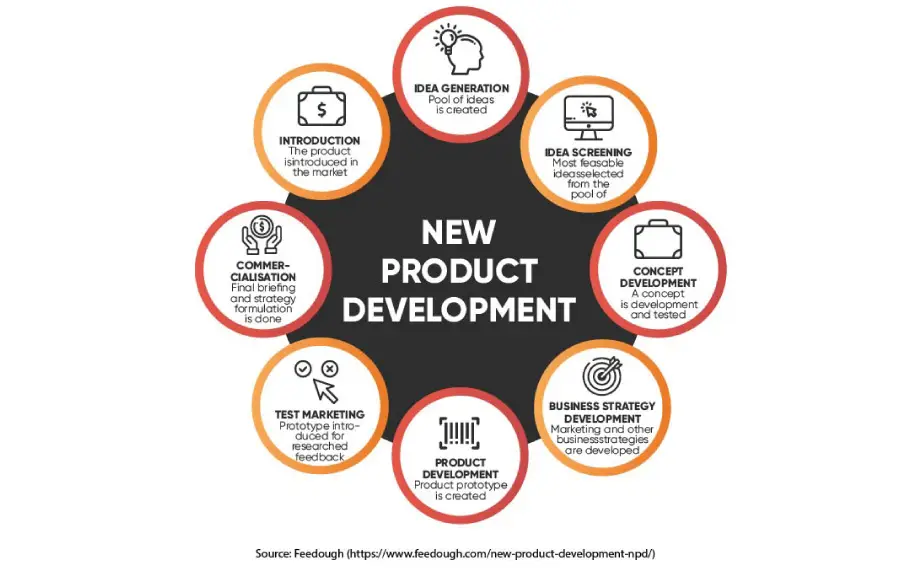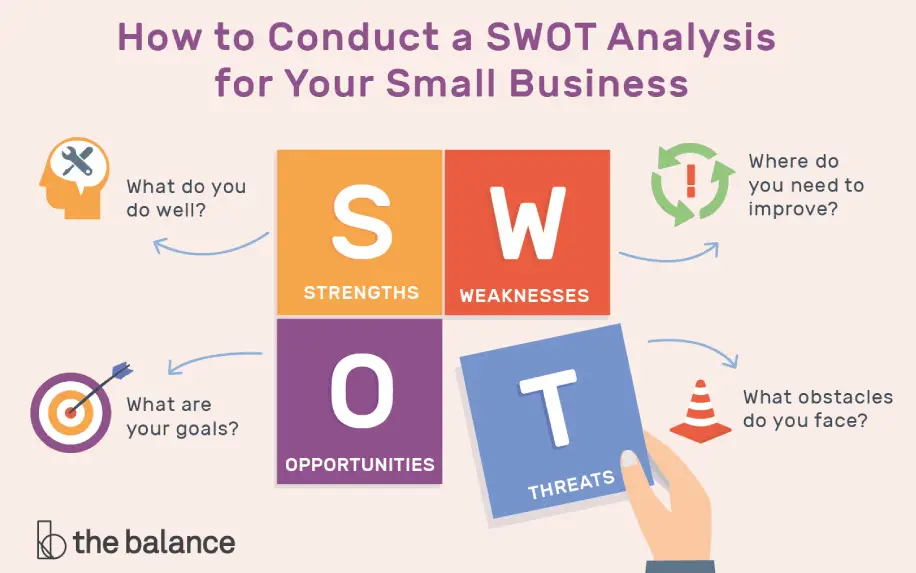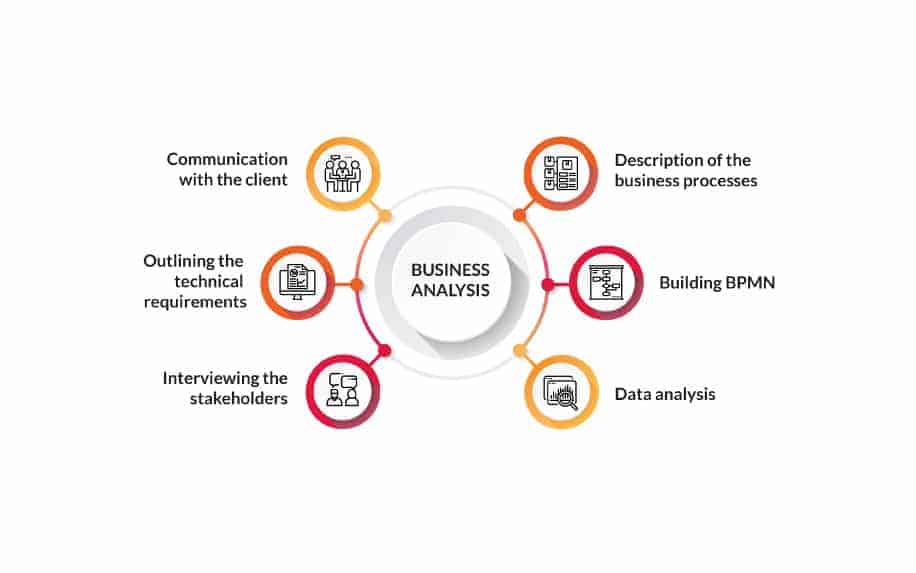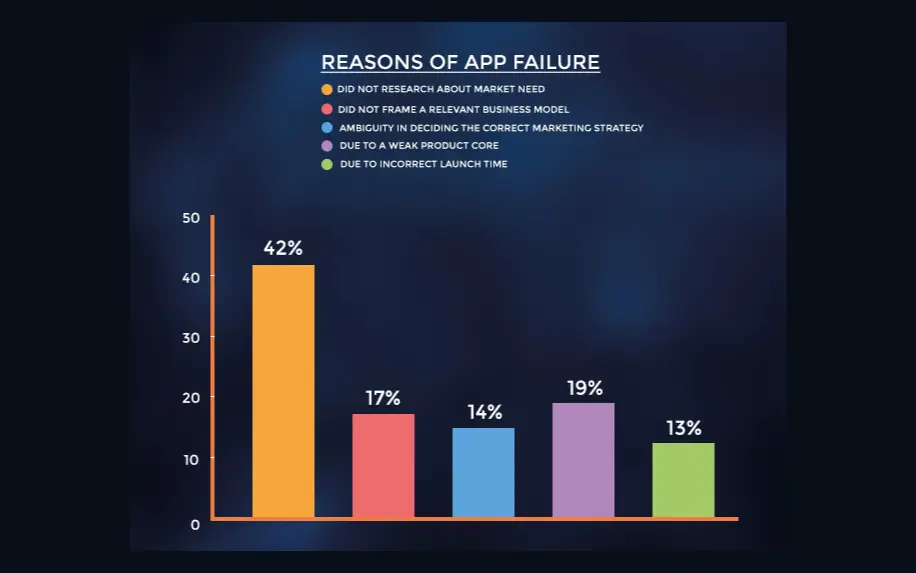In the world of business, everything should be well-researched and thoroughly planned and introducing a brand-new product is no exception to that rule. In fact, it would be complete insanity to bring a new product to market without first conducting a new product development process.
Preparing for a new product to hit the market should be anything but random. There is a defined new product development process that is translated into clear steps – but for budding entrepreneurs, this may be a baffling mission. However, following this product development strategy guarantees the best results when the product reaches the final stage and faces the market.
In this article, we’ll explore each step of the new product development process, outlining some examples and helping you get to grips with this very important marketing tactic.
Table of Contents
What Is the New Product Development Process?
The ‘new product development process’ is a process that involves a number of steps that should be done before introducing a new product to the market. It includes all product development stages starting from the initial idea phase right through to the launching phase.
The New Product Development Process in Seven Stages:
Coming up with new product ideas is never easy. As such, it’s important to have a clear system in place to generate valuable new ideas. The new product development process consists of seven steps:
- Idea generation,
- Idea screening,
- Concept Development and testing,
- Business analysis,
- Product development,
- Market testing,
- Commercialisation and launch.
Do not forget that launching a new product is like trying something for the first time. It includes a lot of expectations and estimations. The new product development cycle helps you create a product that matches the market’s needs.
The 7 Stages New Product Development Process
There are seven key stages to developing a new product. In fact, you can break the whole process down into systematic stages. That way, you’ll always be able to reliably come up with new product ideas by following this process.
The core steps for developing a new product are:
- Idea generation,
- Screening,
- Concept development and testing,
- Business analysis,
- Product development,
- Market testing,
- Commercialisation and launch.
Now that we know this overview, let’s take a look in more detail at each of these steps in the product development process and how you can start conducting your own research for product launching success.

Step 1: Idea Generation
The first step in the product development cycle is idea generation which is a lot like brainstorming. In this phase, the goal is to collect a pool of innovative concepts and ideas. Any great invention or product starts with a brilliant idea.
Coming up with ideas can be tricky. However, the search can start at home. Almost 55% of all new product ideas come from internal sources.
Ask employees
Your staff are one of the most valuable resources to understanding your customer’s needs and identifying opportunities for new products. Ask your employees, especially those in direct contact with your customers the following questions:
- What do they think your customers need?
- Do they have a specific frequent request?
- What are their complaints usually about?
The answers to such questions can inspire you to come up with good and practical ideas that your customer base values and appreciates. Brands that listen to their customers also build consumer loyalty -they feel listened to and your new product reflects that.
Ask the customers
Another great source is your customers themselves. The best way to know what the customers need is by simply asking them. Listen to their feedback, conduct surveys and gather up information that can help you develop new ideas that are based on their wants and needs.
SWOT
In addition to these two sources, a SWOT analysis is a considerable way to create new product ideas. A SWOT analysis is identifying your company’s:
- Strengths,
- Weaknesses,
- Opportunities,
- Threats.
By understanding your current SWOT position, you can start to identify opportunities for a new product that would help minimise competitor threats, build upon your weaknesses, etc. By comparing these to your competitors and to the market needs as well, you will have some ideas of what your next product should be or at least, what direction it should be going in.

Step 2: Idea Screening
The second step of the new product development company process is built on the first. You have gathered as many ideas as you could and put them in a list – now it is time to cross out inadequate ideas, sorting through the best to the worst.
Filtering your ideas means evaluating each one based on specific factors. ROI, affordability, and market potential are three major factors that should determine the utility of these product ideas.
ROI is an equation that measures how profitable an investment is by dividing the net profit by the amount of money invested in that product. You can guess what affordability is. Yes, whether or not your budget allows you to turn this idea into a real product.
Finally, the market potential is the estimated sales revenues of the product when it reaches the market. Rating your ideas according to these three factors will give you an insight into the best handful. The appropriate decision-makers should select the most useful idea.
Filtering ideas
Idea screening is an important early stage of the new product development process where initial ideas get evaluated and filtered based on key factors. Here are some other tips on effective idea screening:
- Establish clear screening criteria – This may include strategic alignment, market potential, technical feasibility, competitive advantage, cost considerations, etc.
- Involve key stakeholders – Get input from your key stakeholders i.e.) engineering, marketing, operations, and customers to assess ideas from different perspectives.
- Leverage market research – Use market data, customer surveys, and focus groups to gauge demand and get feedback on concepts.
- Do preliminary technical assessment – Understand at a high level the technical requirements to produce and deliver the product.
- Analyse competitive landscape – Evaluate competitor products, positioning, and possible responses.
- Review strategic goals – Ensure the idea aligns with the company’s vision, objectives and roadmap.
- Estimate broad financials – Conduct high-level financial projections to assess profitability and risks.
- Rank ideas on key criteria – Use a weighted scoring model to rate and rank each idea on the key factors.
- Set clear go/no-go criteria – Define the thresholds, hurdles, and gates that will determine if an idea moves forward.
- Test concepts quickly – Develop simplified prototypes or storyboards to test the concept quickly with target customers.
The goal is to filter down ideas efficiently to the most promising ones to invest in further. Balancing thoroughness with speed is important during the screening process.
Step 3: Concept Development and Testing
The main goal of the second step was to find out the best product idea. The third step of the new product development process aims to turn this product idea into a product concept – but what is the difference between these?
A product idea is an idea for a product that the company can see itself marketing to customers. Meanwhile, a product concept is a detailed version of the idea stated in meaningful consumer terms. It’s the idea you’re opting to go ahead with and have interested time, energy and resources into developing.
Having created a properly designed concept, the trial is the very next thing you should do. If the concept has been properly designed, the consumer should be able to visualize it. Introduce your concept to a small sample of consumers, and examine your concept.
Trial and testing questions
You should anticipate (actually welcome) responses and critiques regarding your new product. Ask the small sample of consumers the following questions:
Do they understand what it is?
Is it useful?
Is it what they expect from your company?
Is it something they would consider purchasing?
These are important questions that you should investigate, take them on board, modify your concept accordingly and keep testing every version of your concept till you reach the best outcome. This is the time for trial and error so that your product launch will have the best chance of success when it reaches the market.
Step 4: Business Analysis
Let’s get down to business. This phase of the new product development process is about setting up profit expectations, which is essential if the product is to be considered a success. Ask yourself the following questions:
What is your margin of profit with this product?
How many do you need to sell in order to make it worthwhile?
What is your sales forecast and is it realistic?
These can be tough questions to answer and they require you to think unbiased, no matter how good you think your product is, it needs to be a worthwhile venture and offer a strong return on investment. Without this type of business analysis, stakeholders will be uncertain and it may not hit the market in the way you hope it will.
Product positioning
By now you do have a specific product concept. So, this step entails planning a detailed marketing strategy that includes determining your target consumers and defining product positioning. Product positioning is an element of a marketing plan that tackles customer needs, competitive pressures, and communication channels.
The business analysis also includes product pricing, distribution, and your available marketing budget. Once again, all these factors and suggested strategies must be evaluated and must succeed at meeting the company’s objectives and customer expectations.

Step 5: Product Development
At this point of the new product development process, your product is ready to become a prototype or the first version of a product.
You will have a tangible model of the product, and once again you will put it to the test. It is safe to say that the whole process holds a trial-and-error approach. You can ask consumers for their opinion about the design, the shape, and the quality of your product.
Based on their reviews you can apply some improvements and tweaks to your prototype. Your product should reach its best, possible, form before it is ready for the next step.
Step 6: Market Testing
Market testing allows you to dip your toe in the water of how your product will perform once launched. Consider these market testing techniques to ensure that your product is well-received by target consumers. follow the steps listed below.
- Create more prototypes and release them in select areas, preferably those that are the closest to your target customers.
- Evaluate how the market responds to your product. Do customers love it? If not, what is wrong with it?
- Assess the pricing of your product, the number of sales it makes, in addition to your marketing messages.
- Are your marketing messages strong enough to engage your customers? Do they show the positives of your product?
Make the changes
The aim of this phase of the new product development process is to validate the concept and the whole surroundings of the product launch. The core idea here is to figure out if anyone would actually pay for your product. That is, do people like it enough that you’d be able to charge enough money to turn a profit? If the answer is no, then you’ll unfortunately have to go back to the drawing board – but that is still a lot better than launching a doomed-to-fail product.
Based on the results of this market testing phase, you should now add the finishing touches and tweaks to your product. Ensuring that you, potential consumers and stakeholders are happy before the product launch. Remember that it is always best to launch with a finalised product as opposed to making changes once it has hit the shelf, if you do the latter you risk losing momentum and damaging the consumer’s first impression of the product.
Step 7: Commercialisation and Launch
The next step is the final and most important step, product launching. Therefore, this is your last chance to alter anything about the product. This includes everything from your initial idea to the pricing and everything other step in between – although you should already have this figured out in the previous product development stage.
Marketing Strategy
Now it’s time for launching your product with a tailored marketing strategy. Estimate the market demand, identify your target consumer, and decide on which marketing channels you are going to use. Make sure your marketing tactics cover digital channels as well.
Some marketing tactics that work particularly well for product marketing include:
- Video content
- eCommerce web design
- SEO blogs and website content
- Social media marketing
- Customer reviews
Utilizing these tactics will help prepare your customers for the launching of a new product. You should also consider a multi-thronged approach as just using one of these methods will not generate the results for optimal product marketing. Decide on at least three tactics and invest time and energy into them. Without a concrete marketing plan, your product risks falling flat when it finally hits the shelves.
Determine when and where your product will be launched, and keep tracking your product closely, observe its numbers and analyse them. This will help you learn from any mistakes and avoid them in the future.

New Product Development Process With Example
Check out this example of a New Product Development Process. It might not be specific to your business, but it will give you a good idea of how to conduct one that is relevant to your industry.
- Ideation – Generating ideas for new products based on market research, customer feedback, internal brainstorming, etc. Example: A bakery decides to develop a new line of artisan breads.
- Concept Development – Developing the product concept based on the initial idea and market research. Example: Artisan bread focused on quality ingredients, unique flavours, and handmade appeal.
- Feasibility Assessment – Evaluating the product for technical and economic feasibility as well as market viability. Example: Forecasting costs, sales, risks, and profitability of the new bread line.
- Prototype Development – Creating one or more early-stage prototypes to test the product design. Example: Making some sample bread recipes on a small scale.
- Consumer Testing – Getting feedback from potential consumers to refine the product. Example: Having a focus group taste the prototype breads.
- Design Finalisation – Finalizing the product design and engineering details. Example: Establishing recipes, production process, packaging, etc.
- Market Testing – Testing the product and marketing plan on a small scale. Example: Selling at a local farmer’s market for initial response.
- Commercialisation – Full launch and production of the product. Example: Rolling out the new artisan bread line across all retail store locations.
- Post Launch Review – Assessing market response and making tweaks. Example: Adjusting bread varieties based on sales.
The process is iterative with consumer feedback incorporated throughout, each stage aims to refine and validate the product for successful commercialisation. Of course, this example may also simplify the process – it will be a lot more technical and intensive in the practical application – but it’s important to have these steps in mind to help guide you in knowing to trust in the process.
Another example of the New Product Development Process
Let’s explore the new product development (NPD) process using the example of developing a new smartwatch:
- Idea Generation:
- Brainstorming sessions with the R&D, marketing, and design teams.
- Feedback from current customers on what they’d like in a smartwatch.
- Market research to identify gaps in the current smartwatch market.
- Idea Screening:
- Evaluate the feasibility of the ideas generated.
- Consider technology constraints, market demand, and alignment with the company’s brand and capabilities.
- Discard ideas that don’t seem viable.
- Concept Development and Testing:
- Develop a detailed concept of the smartwatch, including features like health tracking, GPS, and customizable watch faces.
- Conduct surveys or focus groups to test potential customer reactions to the concept.
- Business Analysis:
- Estimate the potential sales, profits, and market share of the smartwatch.
- Consider the costs of development, production, marketing, and distribution.
- Product Design and Development:
- Design the physical appearance and user interface of the smartwatch.
- Develop the software and hardware components. Proper software development and hardware components are laying the foundation for your future product.
- Create prototypes for testing.
- Prototype Testing:
- Test the smartwatch prototypes internally for functionality, durability, and performance.
- Conduct beta testing with a select group of external users to gather feedback.
- Market Testing:
- Release the smartwatch in limited areas or to specific user groups.
- Gather feedback on user experience, pricing, and marketing strategies.
- Commercialization:
- Plan the full-scale launch of the smartwatch.
- Decide on pricing, distribution channels, and marketing strategies.
- Consider global markets and any localization needed for different regions.
- Product Launch:
- Launch the smartwatch with marketing campaigns, press releases, and events.
- Ensure distribution channels are stocked and that customer support is trained and ready.
- Post-Launch Review and Feedback Integration:
- Monitor sales, customer reviews, and feedback.
- Address any issues or bugs reported by users.
- Plan for software updates or new features based on feedback.
- Iterate and Improve:
- Based on market feedback, release new versions or models of the smartwatch.
- Continuously innovate and add features to stay competitive.
Throughout this NPD process for the smartwatch, it’s essential to maintain open communication among all teams involved and to be flexible, adapting to feedback and changing market conditions. The goal is to ensure that the final product meets customer needs and expectations while aligning with the company’s strategic objectives.
Why Are Product Development Phases Important?
The new product development process is crucial for several reasons, as it directly impacts the success of a product, the profitability of a company, and the satisfaction of customers. Here are some of the primary reasons why the product development process is important:
Ensures Clear Vision and Direction
A structured product development process provides a roadmap for teams to follow, ensuring that everyone is aligned with the product’s goals and vision. It also provides a framework to ideate, iterate, and deliver new products desired by customers, keeping product offerings fresh and competitive.
Risk Mitigation:
By following a systematic approach, potential issues can be identified and addressed early, reducing the chances of costly mistakes or product failures. A structured process allows early testing and validation to identify flaws and improve the product before larger investments are made.
Resource Optimisation
A well-defined process ensures that resources, be it time, money, or manpower, are used efficiently and not wasted on redundant tasks or features that don’t align with market needs. These defined steps also enable cross-functional teams to work seamlessly towards launch, preventing wasted time and resources.
Faster Time-to-Market
A streamlined process can accelerate product development, allowing companies to launch their products faster and potentially gain a competitive edge. With this method, there is a clear end in sight which helps keep the product development on track and ready to enter the market when the time is right.
Customer-Centric Focus
The process often begins with market research and understanding customer needs. This ensures that the final product is tailored to meet the demands of the target audience, leading to higher satisfaction and adoption rates. Direct customer feedback throughout ensures products are tailored for target users and aligned with their needs.
Quality Assurance
A structured development process includes testing and quality assurance phases, ensuring that the final product is of high quality, free from critical bugs, and meets industry standards. Vetting, prototyping, testing, and refinement at each stage, will result in better products.
Facilitates Collaboration
The product development process often involves cross-functional teams, from design to engineering to marketing. A clear process fosters collaboration and ensures all teams are on the same page. Ensure that your new product development process is conducted with an appropriate team because everyone has valuable input to give.
Cost Efficiency
By identifying and rectifying issues early, optimising resources, and avoiding feature creep (adding unnecessary features), companies can save significant costs and develop a product that delivers value, without cheap marketing gimmicks that can potentially annoy or frustrate customers.
Strategic Alignment
The process ensures that product development aligns with the broader strategic goals of the company, ensuring cohesion and synergy across different initiatives. Whether that’s expanding into an entirely new industry, or building credibility and expertise within an existing one – the new product should reflect that clearly.
Builds Brand Reputation
Consistently releasing well-designed, user-friendly, and reliable products enhances a company’s reputation in the market, leading to increased trust and customer loyalty. New products can help position your brand as innovative and industry-leading.
The product development process is not just about creating a product; it’s about ensuring that the product is relevant, reliable, and resonates with the target audience. A well-defined process leads to better products, happier customers, and ultimately more successful businesses.
Therefore most of the stages of product development involve trying and testing the product more than once and twice to guarantee the best possible outcome. Do not limit your ideas, and do not be afraid to risk or try something new, as long as you will test it before launching.



Amasing! very useful. The only problem we have as small businesses is Costs of becoming big!
Thank you. This summary list is very helpful guide.